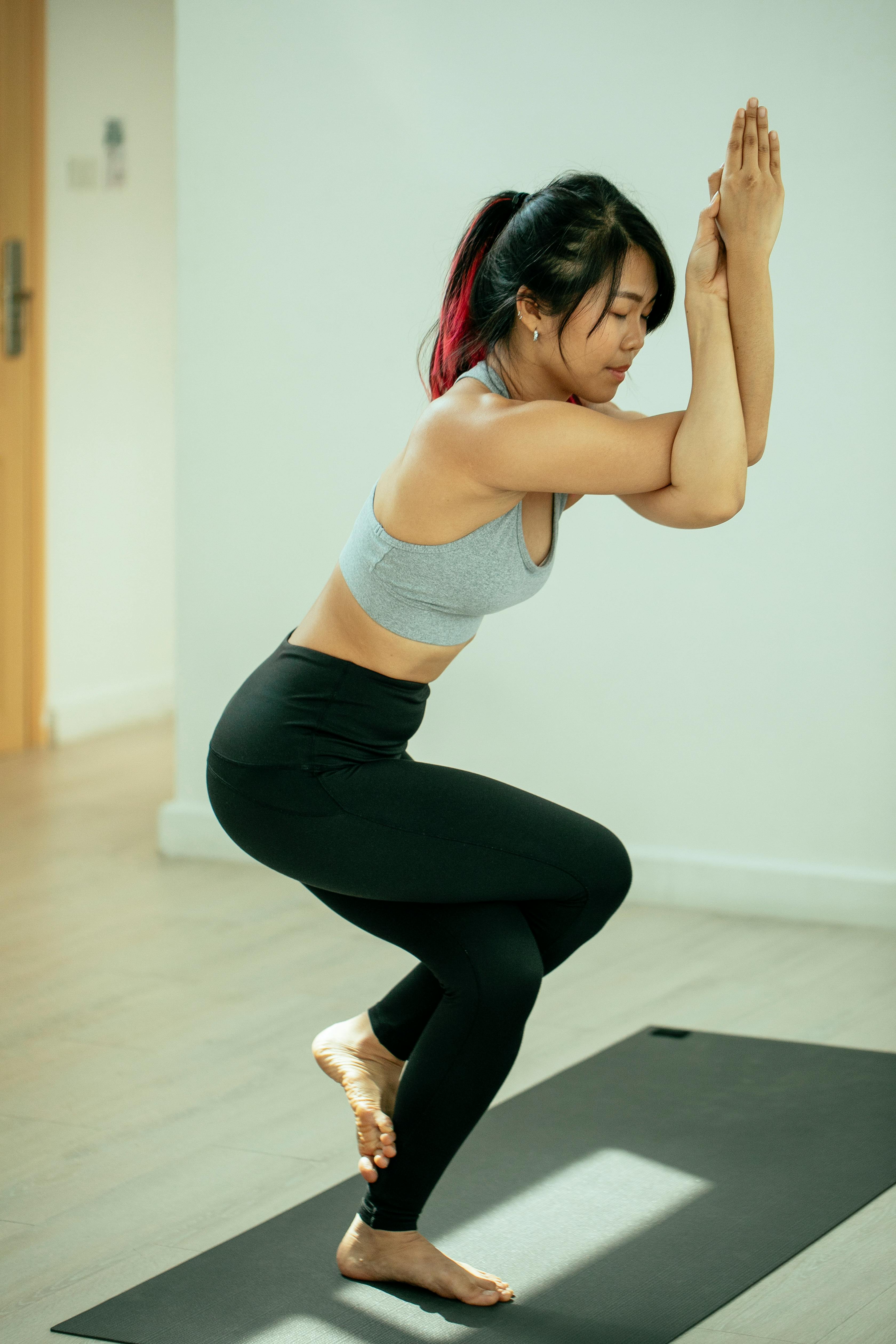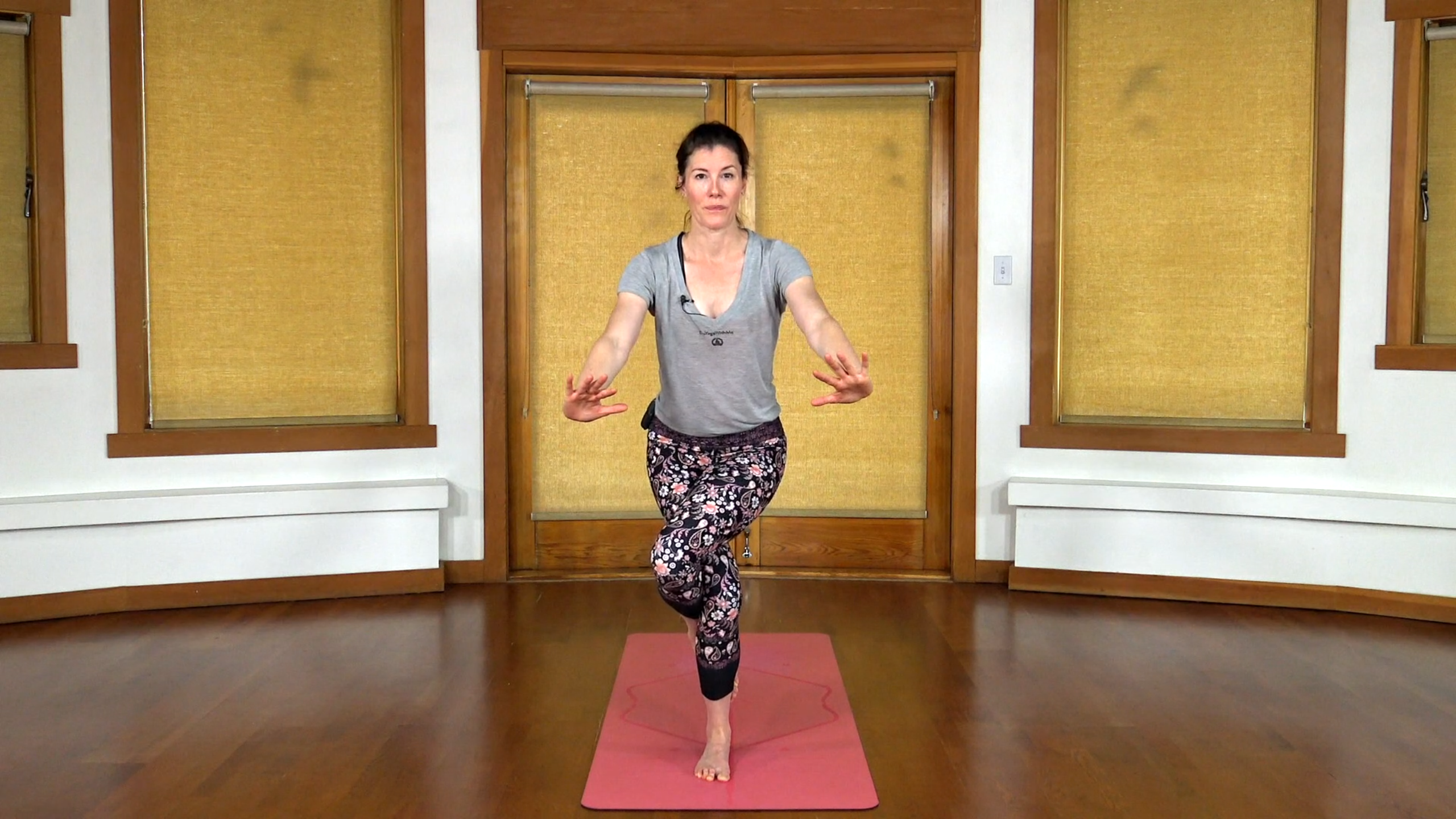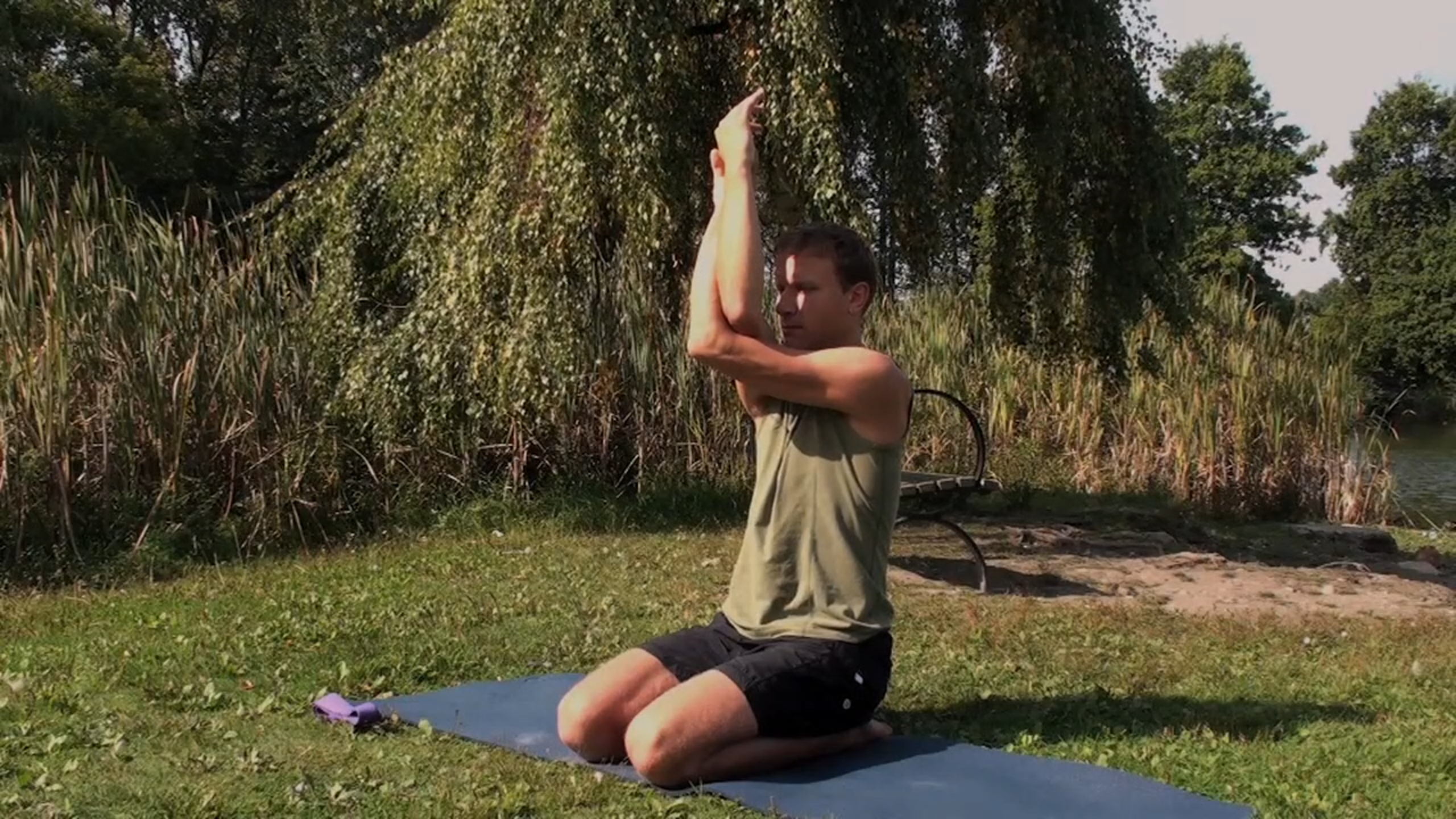The Sanskrit word Garuda can be translated as “eagle,” making the yogic posture garudasana mean “eagle pose.”
Garuda isn’t just any old eagle, though.
According to Hindu mythology, Garuda is the king of the birds. In South Asia, the mythical bird is depicted as a shining, winged man. His body is frequently portrayed as red or gold, while his face is typically that of an eagle or a man’s face with an eagle’s beak.
Impressed by his power and strength, the God Vishnu blessed Garuda, making him a demigod. When asked how he might serve Vishnu, the God asked Garuda to be his vehicle.
Garuda and stories involving this fierce, mythical creature express several themes that can inform and inspire our yoga practice.
Drawing Inspiration from Garuda
Garuda is associated with many powerful ideas that can help us get the most from our yoga practice.

Two texts are dedicated to Garuda: Garuda Purana and Garuda Upanishad.
The former includes theoretical yoga texts concerning how to practice yoga for personal development and to deepen one’s self-knowledge.
The latter, one of 108 Upanishadic Hindu scriptures, contains mantras supposed to fight against the effects of poison. Garuda is said to have exerted control over snakes and other poisonous animals. Based on this text, some believe practicing Garudasana regularly can eliminate negative energy from the body.
According to Buddhist and Hindu stories, Garuda is dedicated to killing snake-like Nagas. The root of this animosity can be traced back to when Garuda’s mother and the mother of the Nagas were married to the same husband.
This god granted his wives one wish each.
The Nagas’ mother requested a thousand children.
Garuda’s mother, however, demanded only two children… and that each of them be more powerful than a thousand Naga children.
Ouch.
The one-upmanship continued until Garuda’s mother lost a bet and ended up servant and prisoner to the mother of the Nagas.
Garuda freed his mother by completing the task of stealing an immortality elixir from the gods, the only thing that would ensure her safe return. (In this version of the story Nagas have split tongues because they licked the grass where Garuda spilled elixir).
Adaptability
Garuda overcame several challenges on the way to gain access to the nectar of life.
To overcome his first obstacle, for example, he shrank himself to fly through a narrow passageway filled with sharp, spinning knives.
Able to shape-shift from birth, Garuda’s ability to be flexible to the demands of the situation helped him succeed. His adaptability and willingness to adapt can inspire us to embrace change and flexibility, physically and mentally.
Perseverance
Garuda also represents subsistence, perseverance, and protection.
Garuda’s story can inspire us to find our inner strength and overcome obstacles. Thinking about how he persevered to free his mother from servitude can help us dig deep when the going gets tough and know that we can make progress in our yoga practice.
The eagle was known for his desire to help humanity against demons.
And Garuda is also symbolic of humility and gratitude.
Mindful practice of garudasana—the pose Garuda inspired—can lead to profound changes in our well-being and mental state as well as our physical bodies. It can help us see more clearly. It both requires and inspires perseverance.
Humility
One of the reasons that Garuda is associated with humility is that when he was born from an enormous egg, his wingspan was so large that it intimidated the Gods! Knowing that he would grow even larger with time, they asked him if he could make himself smaller. He obliged and shrank himself physically.
Although he acquiesced and became small—small compared to his original size; it is still said that he was big enough to block out the sun if he flew in front of it—he retained his massive, indomitable spirit.
In a similar way, we can enjoy our inner strength and let our spirits shine, even when we might feel physically small or weak or if we’re suffering from mobility issues, tightness, or an injury. We can still find a way to adapt and shine with unsubdued inner energy.
As the mount of Vishnu, Garuda also demonstrates his great humility. Garuda allows himself to be ridden in what might be described as an act of submission to a higher power. Opening yourself up to a higher power, which you may consider to be nature, the environment, or energy, for example, will ring bells for many yogis and can help guide your practice.
We’re also reminded of Garuda’s ability to carry extremely heavy loads, which can speak to us and inspire us on and off the mat.
Clear Sight
With his eagle eyes, Garuda is also associated with seeing clearly. He can inspire us to see through false ideas, let them go, and find the truth in any situation. In letting go of falsehoods, we can improve our ability to see things as they really are.
Cultivating our awareness of the moment in our bodies and minds will help our yoga practice as it will help us avoid being too hard on ourselves about what we think we should be capable of or pushing ourselves beyond our current abilities. Instead, we can focus on the moment and accept what is true right now.
Benefits of Garudasana
The physical and mental health benefits of garudasana include:
- Mental clarity—Being in garudasana will develop and calm your mind and body.
- Improved concentration—To balance physically, you require mental stillness.
- Better physical balance—The pose asks you to balance your entire body on one leg.
- Strengthens the legs—With your body weight supported by one leg at a time, you may notice your legs getting stronger when you practice this pose regularly.
- Physical flexibility—The pose implicates many joints and muscles, particularly those in the arms and legs.
- Stretches the arms and legs—Attaining the pose and correcting your form and balance involve stretching.
- Stretches the back and shoulders, including the rhomboids, lower trapezius, deltoids, latissimus dorsi, and teres major.
How to Do Garudasana
Garudasana is typically considered an advanced pose, so beginners and intermediate-level yogis should take it slowly.

Perform the pose mindfully, noticing how it feels and what it does for your body and mind rather than concerning yourself with “how the pose is supposed to look.” Your garudasana does not need to look like everyone else’s to be garudasana.
Preparation for Eagle Pose
Garudasana demands high levels of focus. In preparation, it’s a good idea to bring your awareness to the breath. It’s a great opportunity to quiet the mind and be in the present, which will help you perform this challenging pose and get the most out of it.
Steps to Garudasana
First, the arms …
- In mountain pose (tadasana), take time to focus on your breath and cultivate a feeling of being grounded.
- Extend your arms out to the sides, at about chest height.
- Cross your right arm over your left arm so that your right elbow sits on top of your left elbow. If possible, connect your arms above the elbows.
- Without losing that connection between your arms or elbows, point your fingers up.
- Take your left fingers into your right palm.
- Move your hands away from your forehead.
- Stretch your arms up while dropping your shoulders.
- Sink down, grounding your lower body.
- Breathe deeply, feeling the stretch in your back.
And now the legs …
- Bend both knees slightly.
- Lift your left foot.
- Internally rotate the left hip.
- Now place your raised left thigh over your standing right thigh.
- You may curl your left foot behind your right calf if you can do so without strain in your knee or point your toes toward the floor.
- Squeeze your legs together and sink a little deeper into the pose. Breathe.
DYWM Classes for Exploring Garudasana
It can be tricky putting it all together, so why not work with Rachel and David to break the pose down into legs and arms?

Attempting to move the knee in an unnatural way is a common problem for students learning garudasana. In Happy Knees in Eagle Pose, Rachel demonstrates the mechanical advantage of internally rotating the thigh. She emphasizes that it’s not the look of the pose that counts but making the hip a hinge, not twisting the knee.

David isolates the movements for the arms in Eagle Pose – Arms Only (Garudasana) with some great advice to focus on staying relaxed.
“Soften where you feel the stretch.”
This gentle class will help you ease into the eagle pose so that it begins to feel effortless.

Fiji’s Birds of a Feather is an intermediate, playful, Vinyasa-style class that includes crow pose (kakasana), pigeon pose (kapotasana), and, of course, eagle. She begins by helping you tune into your breath, creating a rhythm to guide, sustain, and inform your practice. (Somehow, she knew I was clenching my teeth).
She then takes you through dynamic movements to stretch and warm up the body in preparation for challenging poses, including garudasana, which is about 12 minutes into this wonderful 36-minute yoga class.
Putting It All Together
The mythology of Garuda can inspire you in powerful ways, on or off the mat.
Garuda’s adaptability, which we can see in his shapeshifting ability, can remind us to be flexible in our approach to our yoga practice. It can remind us to use variations of asanas and make full use of props whenever necessary to overcome challenges.
Remembering Garuda’s perseverance can inspire us not to shrink away from obstacles but to overcome them with time and determination.
Garuda’s humility, despite his awe-inspiring power, can keep us grounded as we develop our abilities during our yoga practices and remind us of our inner strength.
And Garuda’s characteristic clear sightedness is a reminder to approach our yoga practice honestly, seeing ourselves and our abilities as they really are, free from unrealistic expectations and self-criticism.
Performing Gardusana is an excellent way to bring this knowledge together, balancing the mutual benefits of the spirituality of yoga with physical postures.












